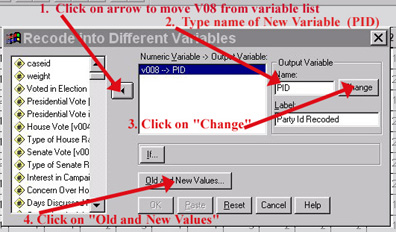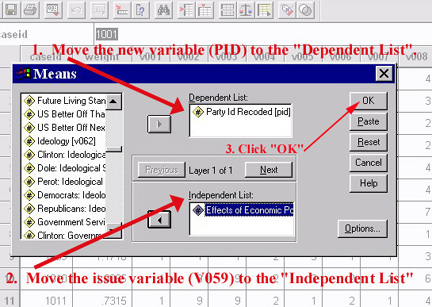
Recode
 The first step in Normal Vote Analysis is to create a new variable for party identification with
values ranging from "+2" for Strong Democrats to "-2" for Strong Republicans. To generate the
new variable:
The first step in Normal Vote Analysis is to create a new variable for party identification with
values ranging from "+2" for Strong Democrats to "-2" for Strong Republicans. To generate the
new variable:
- From the menu bar, select TRANSFORMATIONS;
- Select RECODE;
- Click on "Into Different Variables".
- Click on "Continue"
Using Recode to Create a New Variable
This procedure will create a new variable (PID Party Identification
Recoded) from an old variable (V08 Party Identification). This procedure
is appropriate because we wish to retain the original values of party
identification. By creating a new variable (PID) we will have two
variables: (1) V8 will continue to differentiate between weak party
identifiers and Indepdents who lean in a partisan direction; (2) PID will
have the values for weak partisans and Independent leaners combined, and
will give each catagory a value to permit normal vote analysis.

To generate the new variable, PID:
- Select V008 Party Identification from the variable list;
- Click on Arrow button to move V008 to VARIABLES box;
- Enter name for new variable (i.e., PID)
- Enter the full variable name (i.e., New Party Identification).
- Click on "CHANGE"
- Click on "Old and New Values";
- Click on Continue.

Old and New Values
For single d values (i.e., 1 = Strong Democrat; 4 = Independent; and 7 = Strong Republican)
- In "Old Value" Column(left), Click on "VALUE" enter 1;
- In "New Value" Column (right), Click on "VALUE" enter "+2"
- Click on "ADD" to create list of recoded values.
- Repeat the process for old value "4" to new value "0"; and old value "7" to new value "-2".
To combine multiple old values (i.e., "2" = Weak Democrat, and "3" = Independent Leaning to
Democrat) into a single new value ("+1" Weak and Leaning Democrat):
- Click on "RANGE";
- Enter "2" into the first box and "3" into the second box;
- in NEW VALUE list enter "1";
- Click on "ADD" to add the recoded values to the recode list.
- repeat the process by enter "5" into the first box and "6";
- click on VALUE and enter "-1";
- click on "ADD";
- click on "CONTINUE"
- in previous menu box, click on "OK"

Calculating the Means
To calculate the means of different groups:
- Select "Statistics" from the menu bar;
- Select "Group Means";
- Click on "Means".

The calculation of the mean for each value of the variable you wish to analyze requires
designating a dependent variable and an independent variable. The dependent variable will
always by PID, the recoded Party Identification of the respondent. The independent variable is
the variable you wish to analyze (i.e., in our example, V59 Financial Condition).
- Select PID from the variable list; click the arrow to move
it to the dependent variable box.
- Select V59 from the variable list; click the arrow to move it
to the independent variable box.
- Click "OK" to produce the output.

OUTPUT
The output is really quite straight forward. A mean is computed for the distribution of party
identifiers for each value of the independent variable. Replace "m" in the formula for
calculating the Expected Demographic Vote with each mean, and work the mathematics of the
equation.
Remember:
- Do the division and/or multiplication first, then do the
addition or subtraction.
- SPSS may generate a means with an exponent(see sample). When
the exponent is negative move the decimal to the number of places to the left
designated by the exponent (i.e., with an exponent of -E2, you would move the
decimal two places to the left).

Saving PID in Your Data File
Before exiting SPSS, select "File" from the menu bar and click on
"SAVE". This procedure will save the new variable in the file VOTE96.SAV
so that you can use it in future data analysis without going through the
recode process each time you open the file. Finish by Clicking on "Exit".


 The first step in Normal Vote Analysis is to create a new variable for party identification with
values ranging from "+2" for Strong Democrats to "-2" for Strong Republicans. To generate the
new variable:
The first step in Normal Vote Analysis is to create a new variable for party identification with
values ranging from "+2" for Strong Democrats to "-2" for Strong Republicans. To generate the
new variable:




